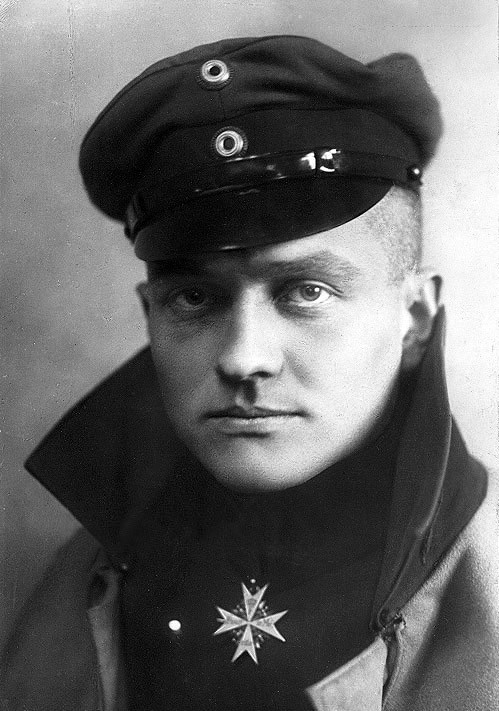Imagine the western front during the spring of 1917. The sound of the whistleblowing indicated the start of an assault. Masses of soldiers crawled out of their trenches and into No Man’s Land. They rushed across the field full of mud, craters, and remnants of failed attacks from years of fighting. While the assault was going forward on land, a fierce battle raged in the sky amongst the angels of death. One of them dove down like a hawk and strafed the attacking force with machine gunfire. Flying in his trademark red triplane with the iron cross depicted on its wings and tail, was a legend respected and feared by both sides of the conflict. His name was Manfred Albrecht Freiherr von Richthofen, also known as the Red Baron. Richthofen was born into a noble Prussian household on the 2nd of May in 1892, becoming an experienced hunter and an accomplished equestrian in his early life. He also developed a reputation for being fearless and a daredevil. When he was ten, Richthofen climbed the highest steeple in Wahlstadt and tied his pocket-handkerchief to one of its lighting rods.1
Richthofen’s father enrolled him into the Prussian Cadet Corp at the Royal Military Academy of Lichterfelde at the age of eleven, and later he was commissioned as cavalry lieutenant and assigned to the First Uhlan Regiment.2 Later, he wrote about this experience in his journal, “I never was good at learning things. I did just enough work to pass. In my opinion, it would have been wrong to do more than was just sufficient, so I worked as little as possible.”3 Upon his graduation in 1912, Richthofen’s first assignment sent him to the Eastern Frontier. While there, the rumor spread that war was on the horizon. Several officers, including Richthofen, believed that the possibility of war was nil. That was not the case for long; the Kaiser ordered the attack on the Russian Front while Richthofen and a few other officers were lunching on oysters and champagne.4
Being a young cavalry officer, his job was to study the ground and harass the enemy. In August 1914, Richthofen rode at the head of his troops for the first time against the Russians at midnight and crossed into Russia with no resistance.5 They captured the small village of Kielzte by quietly arresting the village’s religious leader by locking him in the bell tower of the church. He and his troops held the village for a week, dispatching most of his riders to send messages to the central garrison. A group of Cossacks entered the village. Cossacks served the Russian Empire and were known for their swift, violent attacks and expertise in guerrilla warfare. Only Richthofen and one other troop remained in the town. They retreated in a fashion that resembled a game of “robber and police.” By the time Richthofen and his fellow escapee returned to the main garrison, the rumor spread that Richthofen was killed in Kielzte, which came as a major surprise to him, to say the least.6 The celebration of his return would not last long. Richthofen received orders to move to the Western Front.

While at the Western Front, Richthofen was in small battles at Côte Lorraine and La Chaussee forests. Due to the dense forest and the land, the fighting ground was described as a quagmire due to constant artillery fire. Calvary was useless on the battlefield. The commander reassigned Richthofen to be a dispatch-bearer nearly a mile from the front lines. Being a restless spirit, he quickly became bored, and after several months he had had enough and wrote to his commanding general, “My dear Excellency! I have not gone to war in order to collect cheese and eggs, but for another purpose.”7 At first, Richthofen’s superiors wanted to punish him; however, they accepted his request and reassigned him to the Luftstreitkräfte, the Army Air Corps.
Origin of Early Flight in the Military
When the First World War began, the concept of using flight in the war was not a new idea. The first use of aircraft as a military asset occurred during the American Civil War. Both the Union troops and Confederacy’s troops launched hot air balloons for reconnaissance and as spotters for artillery units. The Wright brothers achieved the first sustained flight of a glider-type aircraft in 1903, and the development of the airplane quickly followed. Soon after its invention, countries integrated airplanes into their militaries. Italy was the first nation to use airplanes in battle during their conflict with the Ottomans in 1911-1912. The Italians were the first to use airplanes in direct combat by dropping four grenades on Turkish troops.8
The warring nations operated airplanes during World War I. Airplanes with various designs and wing configurations served in a variety of roles, from reconnaissance to bombing. As airplanes became more prevalent, pilots of opposing sides confronted each other in mid-air combat, known as a dogfight. During the early stages of the war, pilots engaged in dogfights with nothing more than the pilots’ pistols. The early warplanes were also armed with boxes full of metal arrows and hand bombs to drop on enemy ground positions. As the war continued, military forces upgraded the planes’ armament, upgraded to machine guns mounted on the top wing of the aircraft. Pilots required some training in order to fire while flying and keep their planes intact. In 1916, the Germans invented a synchronization gear that allowed them to shoot through the propeller and not hit the blade. This advancement gave Germans an advantage and led them to dominate the skies.9
The Baron’s first flight
Richthofen was not considered a natural-born pilot. He seemed to be overwhelmed when starting in the Air Corp. Richthofen began as an observer and remained so for the rest of the first year of the war. He finally accomplished his first solo flight on the 10th of October, 1915. When his teacher told him to fly by himself, Richthofen later wrote in his diary that he felt like replying that he was afraid. He did well on his first solo flight until the landing. Richthofen described, “I lost my balance, made some wrong movement, stood on my [Richthofen] head, and I succeeded in converting my aeroplane into a battered school bus.”10
Richthofen quickly improved, thanks to Oswald Boelcke, Germany’s top Ace at the time, and the Father of Air Combat. Boelcke assigned Richthofen to his unit and helped forge the Baron into the legendary Ace that we know of today. Richthofen gained his first confirmed kill in 1916 and started a tradition of collecting mementos from the downed planes.11
Flying Aces
A Flying Ace was a pilot who managed to shoot down five or more planes in total. The term Ace started around 1915 by the French media for propaganda purposes in order to create a cult around the pilots earning the title.12

The Red Baron was considered the Ace of Aces for shooting down eighty planes in all, the highest kill-count during the war. However, he was not the only man competing for the highest title. Each nation fighting in WWI had its top Flying Aces, with at least twenty or more confirmed kills. Closest to the Red Baron, the French pilot named René Fonck was credited with an impressive seventy-five kills by the end of the war. He was followed a Canadian named Billy Bishop with seventy-two kills, and the top English ace was Edward Mannock with sixty-one kills.13
The Man Becomes the Legend
Richthofen was awarded the Pour Le Mérite, the highest honor in the German Empire after his sixteenth kill in 1917. Richthofen also gained command of an air unit, as the Captain of Jagdgeschwader I.

In celebration, he decided to paint his plane red. “For what reason, one fine day I came upon the idea of having my crate painted glaring red. The result was that absolutely everyone could not help but notice my red bird, my opponent also seemed to be not entirely unaware.”14
The red plane provided his desired effect and became his calling card. In one encounter, he shot down an English two-seater plane, whose pilots survived the crash. As Richthofen followed the British fighter to the ground, he suddenly suffered engine problems, forcing him to land next to his opponent’s craft. The two Englishmen greeted Richthofen like sportsmen. The pilots talked, and the Red Baron asked if either of them had seen his plane before. One of them replied, “Oh, yes. I know your machine very well. We call it ‘Le Petit Rouge.’”15

On the 6th of July, 1917, Richthofen received a serious head injury when a bullet went straight to his skull during a dogfight. The injury caused momentary blindness, yet he managed to land in a friendly airfield. X-rays showed the bullet fractured his skull and required several surgeries. Richthofen returned to the field three weeks later against the doctor’s advice. The Red Baron returned a different man. He became depressed and anti-social with his friends and comrades.16
On the 20th of April, 1918, Richthofen managed to get both his 79th and 80th kills in his final days. Both kills were Englishmen flying Sopwith Camel biplanes, the Red Baron’s preferred opponents. Richthofen wrote, “The French attacking spirit is like bottled lemonade. It lacks tenacity. The Englishmen, on the other hand, one notices that they are of Germanic blood. Sportsmen easily take to flying, and Englishmen see in flying nothing but a sport.”17

The day before being relieved of front-line duties, Richthofen set out for his 81st kill. As he chased his opponent, he flew over enemy lines and received a fatal wound. Richthofen managed to land his plane in a nearby field. His last words, “kaput,” were spoken to an Australian soldier. Manfred von Richthofen was a national hero to the German people, and respected greatly by everyone on both sides. A wreath was placed on the Baron’s grave with the phase, “To Our Gallant and Worthy Foe.”18
- Floyd Gibbons and Clayton Knight, The Red Knight of Germany: The Story of Baron von Richthofen (Germanys Great War Bird) (Garden City, NY: Garden City Pub., 2010), 11. ↵
- Floyd Gibbons, and Clayton Knight, The Red Knight of Germany: The Story of Baron von Richthofen (Germanys Great War Bird)( Garden City, NY: Garden City Pub., 2010), 11. ↵
- Manfred Richthofen, The Red Baron (Barnsley, South Yorkshire: Pen & Sword Aviation, 2013), 5. ↵
- Manfred Richthofen, The Red Baron (Barnsley, South Yorkshire: Pen & Sword Aviation, 2013), 9. ↵
- Floyd Gibbons, and Clayton Knight, The Red Knight of Germany: The Story of Baron von Richthofen, (Germanys Great War Bird) (Garden City NY: Garden City Pub., 2010), 14. ↵
- Manfred Richthofen, The Red Baron (Barnsley, South Yorkshire: Pen & Sword Aviation, 2013), 11. ↵
- Manfred Richthofen, The Red Baron (Barnsley, South Yorkshire: Pen & Sword Aviation, 2013), 22. ↵
- Ezra Bowen, Knights of the Air (Alexandria: Time-Life Books, 2004), 18. ↵
- Ezra Bowen, Knights of the Air (Alexandria: Time-Life Books, 2004), 61. ↵
- Manfred Richthofen, The Red Baron (Barnsley, South Yorkshire: Pen & Sword Aviation, 2013), 35. ↵
- Manfred Richthofen, The Red Baron (Barnsley, South Yorkshire: Pen & Sword Aviation, 2013), 51. ↵
- Evan Andrews, “6 Famous WWI Fighter Aces,” History.com (website) A&E Television Networks, (May 22, 2014), accessed the 6th of May, 2020. https://www.history.com/news/6-famous-wwi-fighter-aces. ↵
- Laura Clouting, “8 Celebrity Air Aces Of The First World War,” Imperial War Museums (website), (Accessed the 30th of April, 2020). https://www.iwm.org.uk/history/8-celebrity-air-aces-of-the-first-world-war. ↵
- Richard Darling, “Manfred Von Richthofen, Corgi Aviation Archive, Hobbymaster,” (Flying Tigers, the 5th of September, 2019. Accessed the 29th of April, 2020. https://www.flying tigers.co.uk/2019/manfred-von-richthofen-corgi-aviation-archive-and-hobbymaster-new-model-arrivals/. ↵
- Manfred Richthofen, The Red Baron (Barnsley, South Yorkshire: Pen & Sword Aviation, 2013), 59-60. ↵
- Floyd Gibbons and Clayton Knight, The Red Knight of Germany: The Story of Baron von Richthofen (Germanys Great War Bird (Garden City, NY: Garden City Pub., 2010), 139. ↵
- “Manfred Von Richthofen Quotations at QuoteTab,” QuoteTab (website), Accessed the 28th of April, 2020. https://www.quotetab.com/quotes/by-manfred-von-richthofen. ↵
- Floyd Gibbons and Clayton Knight, The Red Knight of Germany: The Story of Baron von Richthofen (Germanys Great War Bird) (Garden City, NY: Garden City Pub., 2010), 170. ↵




30 comments
Carlos Hinojosa
I was always inspired or looked up to the idea o fighter pilots and courage that seemed to pour out of them like sweat. Especially, back then when flying was basically a death sentence and even living two days in a row was considered a miracle. So a story of a baron that was so deadly that he changed a war is honestly pretty impressive to me. It reminds me of what’s currently happening in Ukraine where one fighter was able to take on whole squadrons by himself and come out unharmed. Fighter pilots will always have my respect. A very good article.
Ruben Becerril
I found this article very interesting, the way you portrayed The Red Baron’s personality was intriguing. Even during battle, he seemed like an upbeat person, I found it surprising that he was able to have a conversation with the enemies he nearly killed. To think that he would become respected by his enemies showed that he was a very skilled fighter.
Jacob Galan
Very interesting and informative article about Manfred Albrecht Freiherr von Richthofen or the Red Baron. I only know him from the Peanuts and my knowledge of the world wars. I was surprised that his father enrolled him into the Prussian Cadet Corp at age 11, really shows how much time has changed. I was also surprised that he was able to keep control of his plane after he had a bullet went straight to his skull and also return to the air after 3 weeks.
Hali Garcia
Great article! I was captivated from the beginning. I have heard of the Red Baron but I did not know anything about him and I learned a lot from this article. It was interesting to read about how early flight was used in war, I had no idea that balloons were used during the Civil War. I thought it was impressive how he was able to have a friendly conversation with the enemies he shot down.
Paulina Gonzalez
What an interesting article! I never knew about the Red Baron or his involvement in the first world war. It’s interesting to read about Italy and Turkey during the first world war and how Italy was the first to use airplanes as warfare. The fact that he cad 81 kills in the air is quite impressive. What is also impressive is how the Red Baron also managed to gain respect from both sides of the war and that there was a sign of kindness/respect towards his enemies.
Karla Fabian
It was interesting to read about The Red Baron, whom I do not know before reading the article; the article did not just inform me about The Red Baron, but also some key facts about the Frist World War I had no recollection of. It was intriguing to read how the Italians were the first to use airplanes in direct warfare against the Turkish troops. It was also interesting to acknowledge how The Red Baron considered the Ace of Aces to achieve the highest kill count during the war, showing how army recognition operated throughout war times. It was also very interesting to see how The Red Baron engaged with his enemies once his plane went down; it showed humanity and kindness even in war times. I had not heard anything like this before, as it is extraordinary to see how a soldier talks and engages with an enemy when war times were very competitive and full of pride.
Christopher Hohman
Nice article! The Red Baron was indeed a remarkable foe in the air. 81 kills! I enjoyed reading how respected he was by soldiers on the both sides of the war and that he even engaged with his “enemies” on friendly terms after his plane went down. Bits like that help remind me that when you forget about rivalries, nationalities etc. what’s left are human beings who certainly have more in common with one another than they might realize. To further this point it was interesting how the allied soldiers gave him a proper burial with a marker to honor their worthy foe. They respected him even though they were enemies. Also, I really like how you incorporated the Baron’s own thoughts and feelings using his diary. Great work!
Ian Mcewen
it is interesting to learn about one of the most infamous pilots the history of the world, and the fact that he was able to gain so many kills with the target painted on his back. it was also interesting to learn about the start of flying’s role in warfare, how they tried to counteract each other, and early innovations in the field.
Santos Mencio
I think it’s a fascinating thing that someone I often consider to be one of the best pilots in human history actually struggled when he first started flying. Although I supposed the take away from that is that a man can accomplish anything if he has the correct guidance. Manfred von Richthofen is a remarkable man that managed to climb to the top and become one of the worlds most well known flying aces. If you like stories about pilots the you should definitely look into the Charlie Brown – Franz Stigler incident, it’s a wonderful story.
Bud Brooks
Very interesting story; thank you. I am curious if you are familiar with a flier who was known as the Black Devil of the Western Front, and served as von Richtofen’s “left-flank” wingman, named Anton T. Rutgers von Rozenburg. He moved to the U.S. after WWI and earned a law degree at a small, short-lived college and law school in downtown Dallas called Dixie University. He was salutatorian of his graduating law class in the 1930s. I have some articles to share with you to give you more context. Thank you.
Seth Roen
No, Mr. Brooks, I am familiar with Anton T. Rutgers Von Rozenburg but I am interested in learning about him. My email is Sroen@mail.stmarytx.edu, and thank you for enjoying my article about the Red Baron.
Seth Roen
Correction, I am not familiar with Von Rozenburg
Bud Brooks
I reached out to the League of WWI Aviation Historians for help, as they are chock full of experts on all things related to that topic. They are very certain that von Rozenburg was none of the things that he says he was. Almost none of his claims match up with known German aviators, and they were struck by the fact that despite flying so many missions, he did not claim any number of kills, which was always the measuring stick for flyers. So von Rozenburg apparently snookered the press into believing his story as it made a number of papers in June of 1933. Very nice piece on the Red Baron, by the way. I will send you some of the articles…